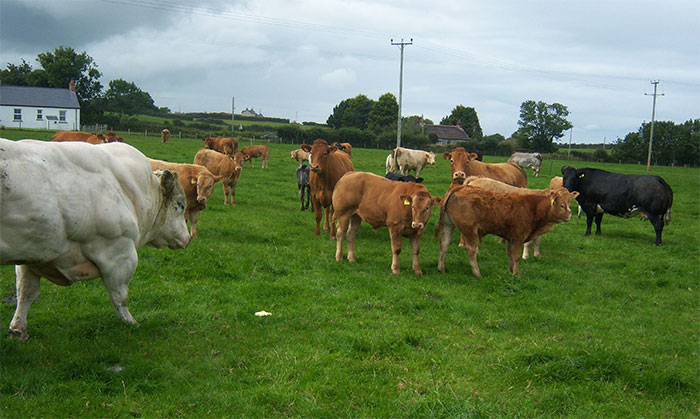
The judges of the BGS Grassland Farmer of the Year Award criss-crossed the UK last week (18-22 August), visiting the three 2014 finalists at their farms in Wales, Northern Ireland and on the Isle of Man.
The Award, which is sponsored by GrowHow UK and DLF-Trifolium sets out to find the ‘best’ grassland farmer in the country, technically and financially, while managing their farm in an environmentally-friendly and sustainable way.
The competition saw a surge in entries this year and there was stiff competition through the local and regional rounds.
The winner will be announced at a ceremony on 17 October in Cheshire at the farm of 2013 winner Mat Venables. This year Mat joined Elaine Jewkes of GrowHow UK, John Read of DLF-Trifolium and Head Judge beef and sheep farmer Glasnant Morgan, to evaluate the eight regional winners and assess the three finalists.
Sam Chesney, Cool Brae Farm, Kircubbin, Northern Ireland
Sam farms 75ha (185 acres) of short and medium term grass leys. He runs 150 suckler cows, 30 following heifers and 120 finishing cattle, with 200 store lambs and 50 lambed hoggets.
This is not the first time Sam has made the final round, having done so in 2011, the same year he won the Farmers Weekly Beef Farmer of the Year. In the meantime he has gone on to win the Danske Beef Farmer and Farm Quality Awards in 2013. The farm is a DARD focus farm for grassland beef and Sam is vice-chair of Agrisearch (beef), working towards low carbon beef production in Northern Ireland.
Sam manages his grassland to keep quality high and the cost of production low. All his leys have been reseeded within the past six years, opting for late heading varieties to help with cutting. Clover is encouraged, with some fields having more than 40%. He grazes paddocks on a 21-day rotation, planning cattle movements using information derived from weekly field measuring and a grass budget calculator.
“Sam is evidently committed to improving the industry; his involvement in knowledge transfer is inspiring and allows him to link research to his farming practice,” commented the BGS judges.
David Collister, Southampton Farm, Port Soderick, Douglas, Isle of Man
David built the dairy unit at Southampton Farm on a greenfield site in 2005 after being given the opportunity to help develop his parents-in-law business. The parlour and infrastructure was designed to accommodate 200 cows, which was a ten-fold increase. David is currently running 140 cows, calving in two blocks but predominantly in the spring, with numbers increasing steadily.
David aims to optimise the return on the investment and to recognise the farm’s full potential. There has been significant attention to putting in tracks and water supplies and recently erecting a new dry cow and calving building.
The farm in total is 129ha (318 acres), some of which is rented on a Farm Business Tenancy (FBT). David’s grassland policy over the past eight years has been to improve the fields systematically, focussing on those with the best potential for return.
Most fields have grown a winter crop, followed by barley and then been reseeded with a high quality grazing ley. The next step is to monitor and tackle underperforming leys.
“David has achieved an astounding amount in a short time, with an intelligent approach to establishing and managing high quality grassland for his herd. His forward-looking approach and passion are evident,” said Elaine Jewkes of GrowHow UK after the visit.
Dafydd Jones, Maesllwyni Farm, Penegoes, Mid-Wales
Maesllwyni extends to 190ha (469 acres) at an altitude ranging from 50 – 300m (164 – 984ft), receiving an average rainfall of 1500mm (59 inches) per year. Dafydd runs a 56-cow suckler herd, 40 finishing animals and 750 ewes organically, supplying Waitrose and achieving a 95% in-specification rate on the lambs.
Cattle and sheep are out on grass most of the time; turn out dates being mid-April and mid-March respectively. Sheep are set-stocked in spring. The cows are turned out after calving and used as a grazing tool, rotating around all the fields. This helps keep weeds down and promotes clover by controlling sward height and vigour.
Clover is of great importance, not just because the farm is organic, but also by pushing up the feed quality of the grazing and silage. Red and white clovers have been sown in new leys, along with high sugar grasses. Other legumes including vetches and birdsfoot trefoil have also been included.
Daffyd has reseeded by undersowing barley/oats with grass, which helps control weeds and increases overall forage production. Some of the upland areas cannot be reseeded and are managed to promote continued productivity from the existing sward, with one field being 60 years old.
“Attention to detail in terms of utilisation of both grassland and buildings was exceptional. Forward planning to ensure quality end product from efficient use of inputs was also demonstrated,” said John Read of DLF-Trifolium.
When the judging was over, head judge Glasnant Morgan summed up by saying: “It has been a real treat to visit these three outstanding finalists and it will be hard to pick the winner.
“There is no doubt that they will be someone who is full of optimism, a strategist, supplying what the market wants, and achieving a premium price for his endeavours by knowing his costs of production.
“We are also taking into consideration producing food in an environmentally-friendly and sustainable way, while using grass to its best advantage. What a challenge!! We will all learn from the winner”.
BGS would like to congratulate all of the nominees in the 2014 competition, recognising that the enthusiasm with which this competition is entered into demonstrates the passion that exists amongst grassland farmers for continued progress.
The Society also applauds the 2014 regional winners who did not make it to the final round: Martyn Vanstone, South West; Jonathan Lampshire, Southern; Ben Charmley, Central-West; Mick Lingard, Central-East and Michael Kyle, Scotland.
